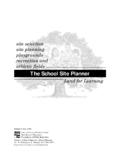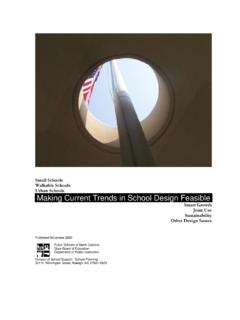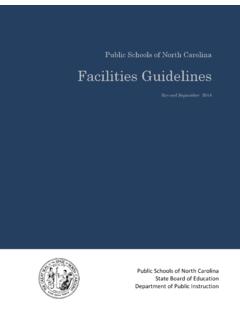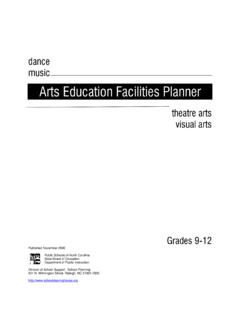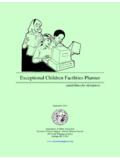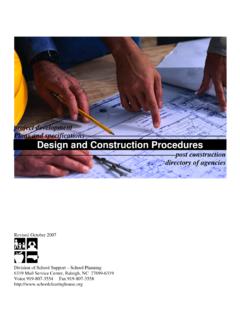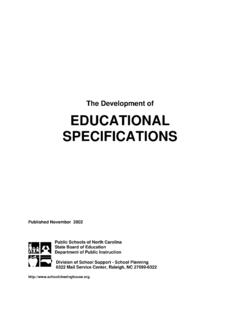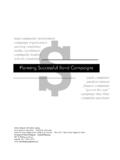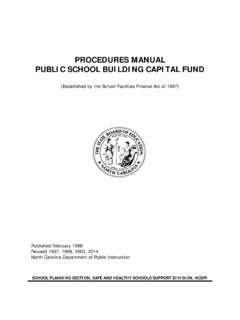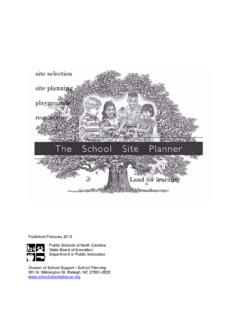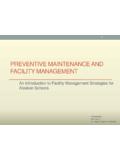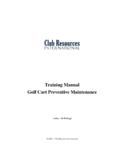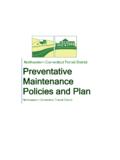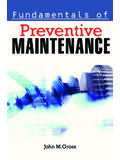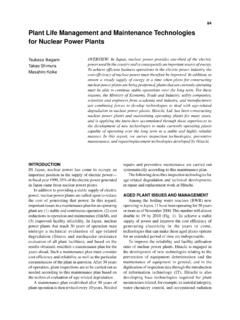Transcription of SCHOOL BUS MAINTENANCE FACILITY PLANNER
1 SCHOOL BUS MAINTENANCE FACILITY PLANNER Published February 2011 Public Schools of North Carolina State Board of Education Department of Public Instruction Division of SCHOOL Support SCHOOL Planning 6319 Mail Service Center Raleigh, NC 27699-6319 http:// 2 Foreword A recent study found that, of all the various modes of transportation used by students in the United States to get to and from SCHOOL , the yellow SCHOOL bus is by far the safest. Only two percent of student deaths in SCHOOL -related traffic accidents are accounted for by bus trips, whereas 25% of the total trips to and from SCHOOL are by SCHOOL bus.
2 A large part of keeping the SCHOOL bus a safe mode of transportation for students takes place in and around the SCHOOL bus MAINTENANCE FACILITY . In North Carolina 14,000 SCHOOL buses were carrying students to and from SCHOOL in 2010. The MAINTENANCE program implemented by the transportation directors and their staff requires properly designed facilities to care for these buses. This publication serves as a source of information for the professional designers, architects, and engineers who will design these facilities and oversee their construction. We hope it will be helpful in the effort to keep the SCHOOL children of North Carolina safe as they travel to and from SCHOOL .
3 William C. Harrison, June St. Clair Atkinson, Chairman State Superintendent State Board of Education North Carolina Department of Public Instruction In compliance with federal law, including the provisions of Title IX of the Education Amendments of 1972, N C Public Schools administers all state-operated educational programs, employment activities and admissions without discrimination because of race, religion, national or ethnic origin, color, age, military service, disability, or gender, except where exemption is appropriate and allowed by law.
4 IiiACKNOWLEDGEMENTS The Department of Public Instruction gratefully acknowledges the contributions of the following, without which the development of this publication would have been difficult. Scott Allen, Transportation Director, Franklin County Schools Roger Ballard, AIA, Consulting Architect, SCHOOL Planning Section, Department of Public Instruction, Raleigh, Bob Bryan, PE, Consulting Electrical Engineer, SCHOOL Planning Section, Department of Public Instruction, Raleigh Paul Clark, Environmental Engineer, Department of Environment and Natural Resources Renee Casali, Architect, Charlotte/Mecklenburg Schools Johnny Clark, Consulting Mechanical Engineer, SCHOOL Planning Section, Department of Public Instruction, Raleigh.
5 Eleanor Dixon, Program Assistant, SCHOOL Planning Section, Department of Public Instruction, Raleigh, David Edwards, , Section Chief, SCHOOL Planning Section, Department of Public Instruction, Raleigh, David Faucette, Transportation Supervisor, Granville County Schools Jack Forshey, Standards Supervisor, Department of Labor, Raleigh, Derek Graham, Transportation Services Section Chief, SCHOOL Support Division, Department of Public Instruction, Raleigh, Bruce Harmon, MAINTENANCE Services Supervisor, Charlotte/Mecklenburg Schools Richard Laird, Manager of Transportation and MAINTENANCE , Charlotte/Mecklenburg Schools Jim Lora, SCHOOL Planning Consultant, SCHOOL Planning Section, Department of Public Instruction, Raleigh, Bob Malone, Mohawklifts, Amsterdam, Phil Mullen, Transportation Director, Cumberland County Schools iv Pam Ray, Program Assistant, SCHOOL Planning Section, Department of Public Instruction, Raleigh, Mary Jane Slipsky, Librarian, Department of Labor, Raleigh, David Sluder, Transportation Director, Caldwell County Schools (former Area Transportation Consultant.)
6 Department of Public Instruction) Baxtor Starr, Transportation Director, Gaston County Schools Ben Styron, MAINTENANCE Coordinator, Transportation Department, Wake County Schools Steve Taynton, SCHOOL Planning Section Chief, Department of Public Instruction, Raleigh, Bobby Ward, Mechanics Supervisor, Cumberland County Schools Ed Warner, PE, Consulting Mechanical Engineer, SCHOOL Planning Section, Department of Public Instruction, Raleigh, \ Craig Warren, Transportation Consultant, Transportation Services Section, SCHOOL Support Division, Department of Public Instruction, Raleigh.
7 Jerel Winslow, Transportation Director, Elizabeth City-Pasquotank Schools Jeff Young, Project Manager, Wake County Schools vTABLE OF CONTENTS SCHOOL Bus Garage Planning Team ..1 Site ..2 General Transportation Personnel/Spaces Needed ..3 MAINTENANCE Bays ..8 Lifts ..9 Parts Storage/Dispensing Room ..14 Body Shop Bay ..16 Paint Spray Bay ..17 Flammable Storage/Mixing Wash Bay ..22 Fluids Tire Repair Room ..25 Tire Storage Room ..28 Battery Room ..29 Machine / Welding Room ..30 Storage ..30 Toilets/ Fuel Dispensing ..33 Suggested Spaces and Areas Per Bus Agencies for Reviews, Permits and Codes and Design Standards (an outline).
8 38 2009 North Carolina Building Code with 2006 International Building Code ..39 2006 International Fire Code ..41 Chapter 9 Fire Protection Chapter 15 Flammable Chapter 22 Service Stations and Repair Garages ..43 Chapter 23 High-Piled Combustible Chapter 25 Tire Rebuilding and Tire Chapter 26 Welding and Other Hot Work ..45 Chapter 27 Hazardous Materials-General Chapter 34 Flammable and Combustible Liquids ..47 NFPA 30A Motor Fuel Dispensing Facilities and Repair Garages.
9 48 NFPA 33 Spray Application Using Flammable or Combustible NFPA 51/NFPA 51B ..52 2008 International Electrical Code ..53 vi Appendix ..54 Floor Plans ..55 Small SCHOOL System (50 buses)..56 Medium SCHOOL System (150 buses)..57 Large SCHOOL System (250 buses)..57 Number of SCHOOL Buses Per County (2010)..58 SCHOOL Bus Sizes/Turning Radii ..58 Recommended Shop Equipment for a SCHOOL Bus Garage ..59 North Carolina Department of Environment and Natural Resources (NCDENR) (List of environmental permits a project may require).
10 61 Photo viiINTRODUCTION State Board of Education policy TCS-H-005 addresses SCHOOL bus inspections, preventive MAINTENANCE and vehicle replacements. The Transportation Services Section of the SCHOOL Support Division of the Department of Public Instruction s publication entitled Bus Fleet: North Carolina SCHOOL Transportation Fleet Manual can be referred to for a full explanation of this program at this web address: . Each vehicle within a SCHOOL system is usually assigned to a specific mechanic. It is recommended that a SCHOOL system have one bus MAINTENANCE garage for each 250 buses (active route buses) or fraction thereof.
